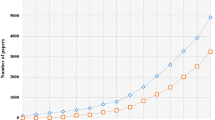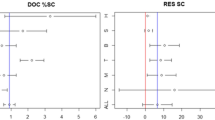Abstract
Web of Science (wos) and scopus have often been compared with regard to user interface, countries, institutions, author sets, etc., but rarely employing a more systematic assessment of major research fields and national production. The aim of this study was to appraise the differences among major research fields in scopus and wos based on a standardized classification of fields and assessed for the case of an entire country (Slovenia). We analyzed all documents and citations received by authors who were actively engaged in research in Slovenia between 1996 and 2011 (50,000 unique documents by 10,000 researchers). Documents were tracked and linked to scopus and wos using complex algorithms in the Slovenian cobiss bibliographic system and sicris research system where the subject areas or research fields of all documents are harmonized by the Frascati/oecd classification, thus offsetting some major differences between wos and scopus in database-specific subject schemes as well as limitations of deriving data directly from databases. scopus leads over wos in indexed documents as well as citations in all research fields. This is especially evident in social sciences, humanities, and engineering & technology. The least citations per document were received in humanities and most citations in medical and natural sciences, which exhibit similar counts. Engineering & technology reveals only half the citations per document compared to the previous two fields. Agriculture is found in the middle. The established differences between databases and research fields provide the Slovenian research funding agency with additional criteria for a more balanced evaluation of research.





Similar content being viewed by others
References
Abrizah, A., Zainab, A. N., Kiran, K., & Raj, R. G. (2013). LIS journals scientific impact and subject categorization: A comparison between Web of Science and Scopus. Scientometrics, 94(2), 721–740.
Aksnes, D. W., Schneider, J. W., & Gunnarsson, M. (2012). Ranking national research systems by citation indicators. A comparative analysis using whole and fractionalised counting methods. Journal of Informetrics, 6(1), 36–43.
Archambault, E., Campbell, D., Gingras, Y., & Lariviere, V. (2009). Comparing bibliometric statistics obtained from the Web of Science and Scopus. doi:10.1002/asi.21062.
Bar-Ilan, J. (2008). Which h-index?—A comparison of WoS, Scopus and Google Scholar. Scientometrics, 74(2), 257–271.
Bar-Ilan, J., Levene, M., & Lin, A. (2007). Some measures for comparing citation databases. Journal of Informetrics, 1(1), 26–34.
Bartol, T., & Hocevar, M. (2005). The capital cities of the ten new European Union countries in selected bibliographic databases. Scientometrics, 65(2), 173–187.
Benoit, K., & Marsh, M. (2009). A relative impact ranking of political studies in Ireland. The Economic and Social Review, 40(3), 269–298.
Bornmann, L., & Leydesdorff, L. (2013). Macro-indicators of citation impacts of six prolific countries: Incites data and the statistical significance of trends. PLoS One, 8(2), e56768.
Chirici, G. (2012). Assessing the scientific productivity of Italian forest researchers using the Web of Science, SCOPUS and SCIMAGO databases. iForest—Biogeosciences and Forestry, 5(3), 101–107.
Curk, L., Budimir, G., Seljak, T., & Gerkes, M. (2006). Linking the SICRIS—COBISS.SI—Web of Science systems. Organizacija znanja, 11(4), 230–235.
Demsar, F., & Juznic, P. (2013). Transparency of research policy and the role of librarian. Journal of Librarianship and Information Science. doi:10.1177/0961000613503002.
Glänzel, W., & Moed, H. F. (2012). Opinion paper: Thoughts and facts on bibliometric indicators. Scientometrics. doi:10.1007/s11192-012-0898-z.
Haddow, G., & Genoni, P. (2009). Australian education journals: Quantitative and qualitative indicators. Australian Academic and Research Libraries, 40(2), 88–104.
Harzing, A.-W. (2013). Document categories in the ISI web of knowledge: Misunderstanding the social sciences? Scientometrics, 94(1), 23–34.
Jacsó, P. (2009). Errors of omission and their implications for computing scientometric measures in evaluating the publishing productivity and impact of countries. Online Information Review, 33(2), 376–385.
Kronegger, L., Ferligoj, A., & Doreian, P. (2011). On the dynamics of national scientific systems. Quality & Quantity, 45(5), 989–1015.
Lasda Bergman, E. M. (2012). Finding citations to social work literature: The relative benefits of using Web of Science, Scopus, or Google Scholar. The Journal of Academic Librarianship, 38(6), 370–379.
Leydesdorff, L., de Moya-Anegón, F., & Guerrero-Bote, V. P. (2010). Journal maps on the basis of Scopus data: A comparison with the journal citation reports of the ISI. Journal of the American Society for Information Science and Technology, 61(2), 352–369.
Lopez-Illescas, C., de Moya Anegon, F., & Moed, H. F. (2009). Comparing bibliometric country-by-country rankings derived from the Web of Science and Scopus: The effect of poorly cited journals in oncology. Journal of Information Science, 35(2), 244–256.
Meho, L. I., & Sugimoto, C. R. (2009). Assessing the scholarly impact of information studies: A tale of two citation databases—Scopus and Web of Science. Journal of the American Society for Information Science and Technology, 60(12), 2499–2508.
Peclin, S., Juznic, P., Blagus, R., Sajko Cizek, M., & Stare, J. (2012). Effects of international collaboration and status of journal on impact of papers. Scientometrics, 93(3), 937–948.
Perc, M. (2010). Growth and structure of Slovenia’s scientific collaboration network. Journal of Informetrics, 4(4), 475–482.
Pumain, D., Kosmopoulos, C., & Dassa, M. (2010). JournalBase—A comparative international study of scientific journal databases in the social sciences and the humanities (SSH). Cybergeo: European Journal of Geography (article 484), doi:10.4000/cybergeo.22862.
Tijssen, R. J. W. (2010). Discarding the “basic science/applied science” dichotomy: A knowledge utilization triangle classification system of research journals. Journal of the American Society for Information Science and Technology, 61(9), 1842–1852.
Torres-Salinas, D., Lopez-Cózar, E., & Jiménez-Contreras, E. (2009). Ranking of departments and researchers within a university using two different databases: Web of Science versus Scopus. Scientometrics, 80(3), 761–774.
Vieira, E. S., & Gomes, J. A. N. F. (2009). A comparison of Scopus and Web of Science for a typical university. Scientometrics, 81(2), 587–600.
Wendt, K., Aksnes, D. W., Sivertsen, G., & Karlsson, S. (2012). Challenges in cross-national comparisons of R & D expenditure and publication output. In Proceedings of 17th international conference on science and technology indicators. Presented at the STI 2012, Montreal, Canada, September 5–8 (Vol. 2, pp. 826–834).
Zibareva, I., & Soloshenko, N. (2011). Russian scientific publications 2005–2009 in the science citation index, Scopus, and chemical abstracts databases. Scientific and Technical Information Processing, 38(3), 212–223.
Author information
Authors and Affiliations
Corresponding author
Rights and permissions
About this article
Cite this article
Bartol, T., Budimir, G., Dekleva-Smrekar, D. et al. Assessment of research fields in Scopus and Web of Science in the view of national research evaluation in Slovenia. Scientometrics 98, 1491–1504 (2014). https://doi.org/10.1007/s11192-013-1148-8
Received:
Published:
Issue Date:
DOI: https://doi.org/10.1007/s11192-013-1148-8




